One of the secrets to successful blogging we’ve learned is knowing exactly who you’re writing for. That’s why choosing the right target audience for your blog is essential.
For example, at WPBeginner, we write for people who are new to WordPress. We make simple guides that show them how to build their first website. Because we know our readers are beginners, we use clear language and break down each step to make it easy to follow.
When you know your target audience, you can write posts that really speak to their needs. You’ll understand what problems they want to solve, what questions they’re asking, and what kind of information they find most helpful.
In this article, we will show you how to find a target audience and connect with them. We will also provide practical examples to make it easier.
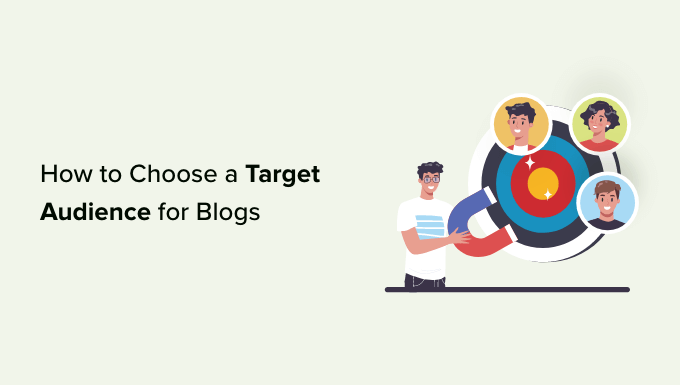
Here is a quick overview of the topics we will cover in this article:
- What Is a Target Audience?
- Why Choosing a Target Audience Is Important
- Types of Target Audiences for Your Blog or Business
- Finding Your Target Audience Using Google Analytics
- Viewing Google Analytics Reports for Your Target Audience
- Building Customer Personas for Your Target Audience
- Creating Content for Your Target Audience
What Is a Target Audience?
A target audience is a specific group of people who share similar interests, needs, or characteristics that make them likely to connect with your blog. Think of it as your ideal readers, the people who will find your content most helpful and engaging.
Whether you are starting a blog or an online business, you can create content that speaks directly to their interests and solves their specific problems.
For instance, a blog about tennis or football may want to reach out to an audience interested in that particular sport rather than sports content in general. This level of specificity often leads to a more engaged and loyal readership.
Similarly, an online store selling pet toys may want to target people who have pets and live around the areas where the store can easily ship products. From our experience, this approach makes marketing campaigns more efficient and effective.
Why Choosing a Target Audience Is Important
Choosing a target audience is important for a blog or online business because it helps them create content and products tailored to that particular group of people. We’ve seen how this targeted approach can substantially impact a website’s success.
This means that the content and products will be more valuable and relevant to the audience, which can lead to more user engagement, higher conversions, and increased sales.
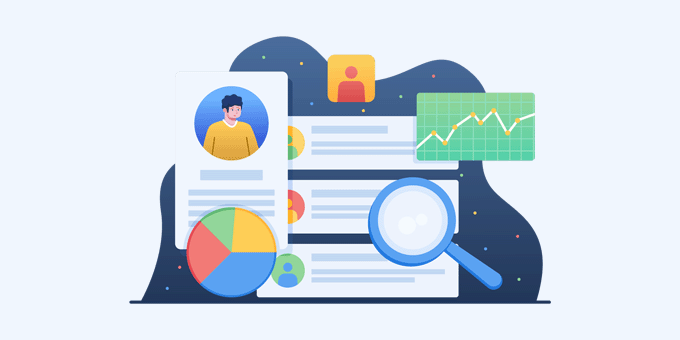
Choosing the right target audience also allows you to plan a more consistent and focused marketing strategy. We’ve found this strategic planning to be key to achieving measurable results.
By understanding interests, age, gender, and location, you can reach the right audience by creating organic content or running paid ads on Google or Facebook. This kind of targeting helps optimize ad spend and improve ROI.
It also helps you more easily establish expertise, experience, authority, and trustworthiness (Google’s E-E-A-T quality guidelines). In our experience, following these guidelines has been crucial in building long-term trust with your audience.
Without a specific target audience, your content risks failing to connect with any particular group of readers on your blog or WordPress website.
This often leads to lower engagement and fewer returning visitors, as readers won’t find the focused, relevant content they’re seeking.
That being said, let’s understand some common types of target audiences and how you would find the right target audience for your blog or online business. We’ve put together some insights that can guide you in making this crucial decision.
Types of Target Audiences for Your Blog or Business
Marketers categorize their target audience based on their intent, interests, location, and other information. The following are a few examples of different types of target audiences:
1. Buying Intent Audience
This type of target audience is looking to make a purchase, which is why it’s called the buying intent.
For example, if you run an eCommerce store selling gym equipment, you may want to target an audience more interested in buying equipment.
These might be people searching for “best home treadmills” or “where to buy weightlifting equipment.”
To connect with this audience, you’ll want to create content that helps guide their purchasing decisions, such as product comparisons, buying guides, and detailed reviews.
Those types of content naturally lead readers toward making a purchase while providing valuable information they need.
2. Information / Educational Audience
This type of target audience is looking for information about specific topics.
For instance, they may need information about workout plans, healthy food recipes, fitness advice, and more.
To target this audience, you’ll need to create content that provides this informational and educational value.
Now, as you can see, you can still have an eCommerce store selling gym equipment, yet you have two different types of target audiences for which you can create content.
3. Demographic Target Audience
This type of target audience is selected based on their demographic information, such as age, gender, location, occupation, income group, and more.
For instance, you may have certain products women are more interested in. Similarly, you may want to reach people in specific locations where you can ship products.
Now, let’s say you want to run Google or Facebook Ads. You can target these specific demographics to make your ads more effective.
To summarize:
- Target audience types can be segmented based on their intents, challenges, and segments.
- A business can have multiple target audiences with different intents.
- Each target audience can be further divided into narrower segments to make your campaigns even more effective.
Finding Your Target Audience Using Google Analytics
Most blog and business owners already have a basic idea of their target audience.
For instance, if you run a travel blog, you may already know your target audience and what their interests are.
However, it is often just guesswork and may not be enough to get you the desired user engagement and customer acquisition you seek.
Smart marketers rely on actual marketing data to choose their target audience and learn more about them.
The biggest source of this data is Google Analytics.
It is a free tool provided by Google that allows you to see where your website visitors are coming from, what they look at, where they are located, and more.
You can also use it to collect demographic data, which allows you to see your audience’s age, gender, and interests as well.
Setting Up Google Analytics for Audience Insights
The easiest way to set up Google Analytics on your blog is by using MonsterInsights. It is the best Google Analytics plugin for WordPress and allows you to easily set up Google Analytics for your WordPress blog.
We use it ourselves, and we love it. For details, see our full MonsterInsights review.
First, you need to install and activate the MonsterInsights plugin. For more details, see our guide on how to install a WordPress plugin.
Note: You can also try a free version of the plugin called MonsterInsights Lite. However, we recommend upgrading to the pro version to fully utilize the plugin.
Once you have activated the plugin, visit the Insights » Settings page in your WordPress admin area and then click on the ‘Connect MonsterInsights’ button.
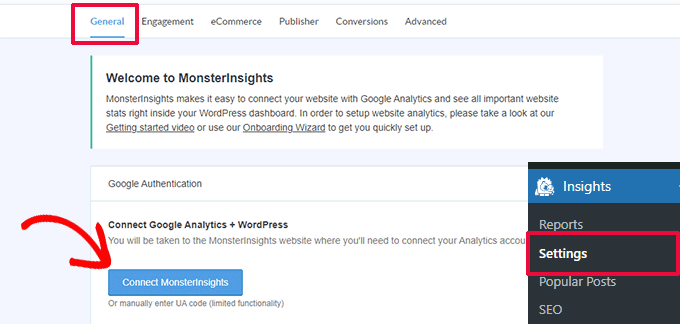
After that, you can follow the on-screen instructions to connect Google Analytics to your WordPress website.
To learn more, see our tutorial on installing Google Analytics in WordPress, which has detailed step-by-step instructions.
Once you have connected to Google Analytics, you’ll need to turn on demographics data in your Google Analytics account settings.
Simply log in to your Google Analytics account and click on the ‘Admin’ gear in the lower corner.
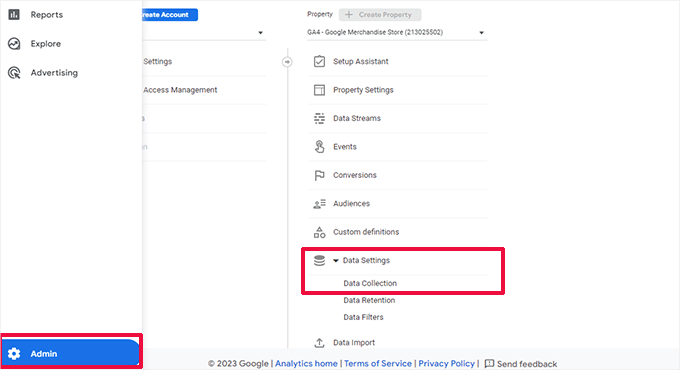
Next, under the property column, click on Data Settings » Data Collection menu.
This will slide open the Data Collection page. From here, you need to turn on the ‘Google signals data collection’ option.
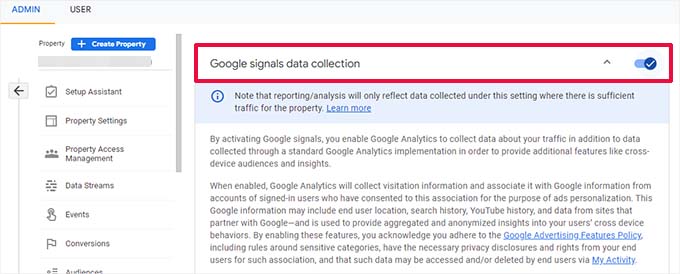
Google Analytics will now start collecting demographic data for your website visitors.
To view this report on your WordPress website, switch back to your WordPress admin area and go to the Insights » Settings page.
From here, you need to click on the Engagement tab and turn on the checkbox next to the ‘Enable Demographics and Interests Reports for Remarketing and Advertising’ option.
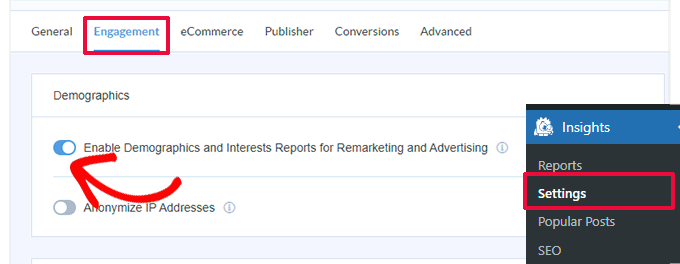
Don’t forget to click on the ‘Save Changes’ button to store your settings.
Viewing Google Analytics Reports for Your Target Audience
Now that you have set up Google Analytics and turned on demographics data, you’ll need to wait for Google Analytics to collect some data.
After a while, you can visit the Insights » Reports page. Under the overview tab, you’ll see the overall traffic performance of your website.
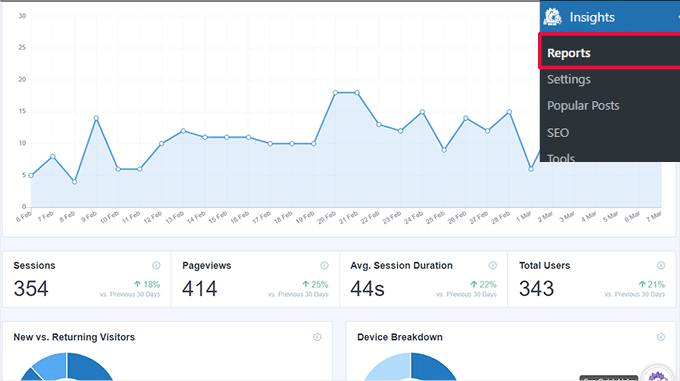
You can also see new vs. returning users and a device breakdown chart.
The device breakdown chart will show you what kind of device your users are using: Desktop, tablet, or mobile.
You’ll also find the top countries your visitors are coming from and your top posts and pages.
Next, you need to switch to the Publisher tab and scroll down a little. From here, you’ll see Age and Gender charts.

The chart will show you a breakdown of users by age and gender.
Note: It is normal to have a large chunk of users marked as unknown. Google only collects data from users who are logged in and have opted in for ad personalization.
Below that, you’ll find the Interests report. This data is collected by Google Signals to help marketers target the right audience. It also helps publishers see the interests of their current website audience.
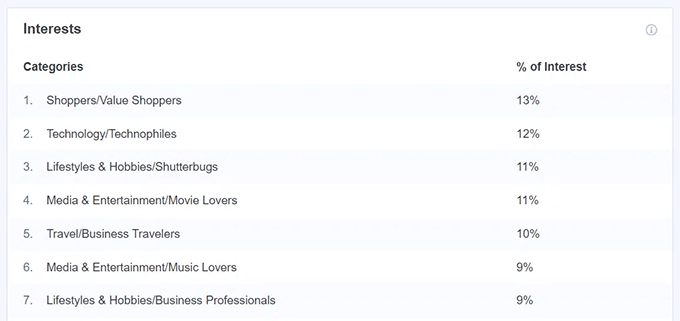
This gives you an idea of what topics interest your target audience the most.
You can further drill down these reports inside the Google Analytics dashboard. Simply go to the Demographics » Demographic details report under your Google Analytics account.
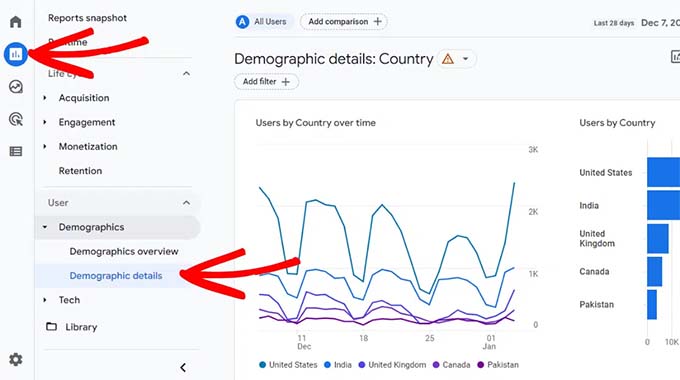
From here, you can narrow down your audience by country and city. You can also see more detailed reports of interests, age, and gender breakdowns.
All of this data gives you a much clearer image of your website’s current audience, and from here, you can choose the target audience you want to focus on.
Building Customer Personas for Your Target Audience
Building ‘Customer Personas’, also known as buyer personas, is a marketing exercise that helps you better understand your target audience.
These customer profiles use the target audience based on the data you have collected in the earlier step.
A good customer persona focuses on the following key elements.
- Goals – What does the user want to achieve?
- Pain points – What are the hurdles and challenges they face in achieving those goals?
- Values and motivations – What drives them to achieve their goals? For instance, it could be personal, professional, or business growth, faith, beliefs, lifestyle, or more.
- Solutions – How your product, services, or content can help them?
There are many ways to generate customer profiles using surveys, customer feedback, and other data sources.
You can also use customer persona generators to fill in the data.
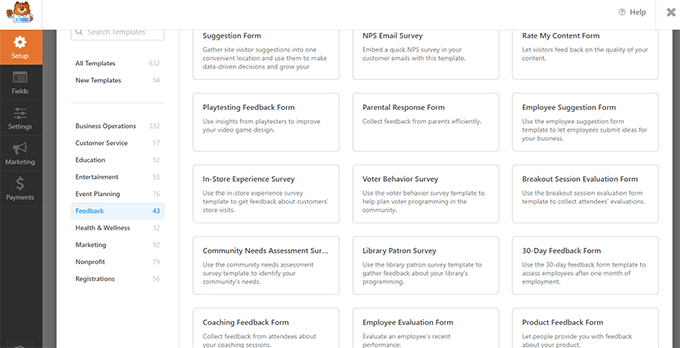
Perhaps the best way to create a target audience profile is by collecting user data directly on your website. You can do so by running surveys, polls, Net Promoter score surveys, feedback forms, and more.
To do this, we recommend WPForms, which allows you to create all types of survey and feedback forms for your website. It even comes with built-in templates to quickly build your forms.
Plus, you can save form data, export it, and use it in other third-party apps to better understand your website audience.
We use WPForms ourselves to create our annual surveys, and love how easy the plugin makes collecting feedback from our readers. For more information, see our detailed WPForms review.
2. Customer Avatar Cheat Sheet by Digital Marketers
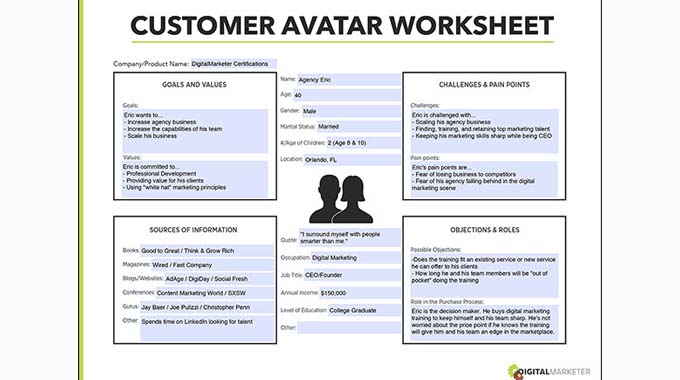
This downloadable cheat sheet helps you fill in a template to generate a customer avatar for your target audiences.
You can provide a name to each customer persona and fill in their average age, gender, and location based on the demographics data you collected using Google Analytics.
After that, you will need to answer the four main sections about their goals, challenges, objections, and sources of information.
The purpose of the exercise is not only to give you a better understanding of each customer persona but also to help you answer and address their objections.
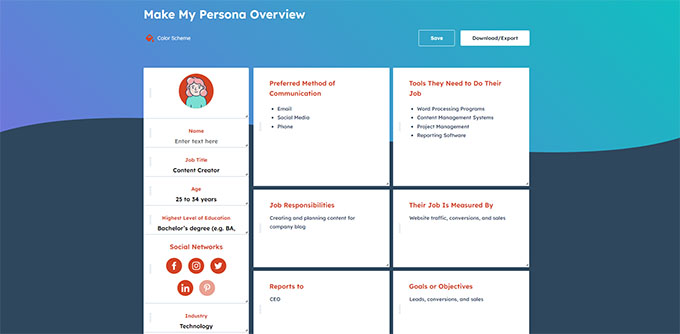
Make My Persona is a free tool created by HubSpot. It allows you to simply answer a few questions to generate a persona for your target audience.
You can then edit the template by manually creating your own sections and adding information to them.
Depending on your business needs, you can then segment your target audience into different categories and create different reader profiles for each segment.
4. UserFeedback by MonsterInsights
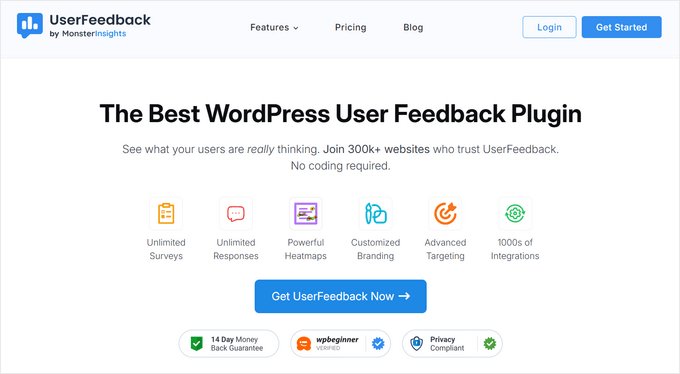
The UserFeedback plugin allows you to run quick surveys on your website and collect direct customer feedback to understand your target audience.
You can show a prompt at the right time and location to ask for customer input, ensuring you get responses when engagement is highest.
UserFeedback comes with multiple question types, unlimited questions, analytics integration, and more. At WPBeginner, we had a great experience using it to understand what our web design customers needed.
For more details, see our complete UserFeedback review which covers all you need to know about the plugin.
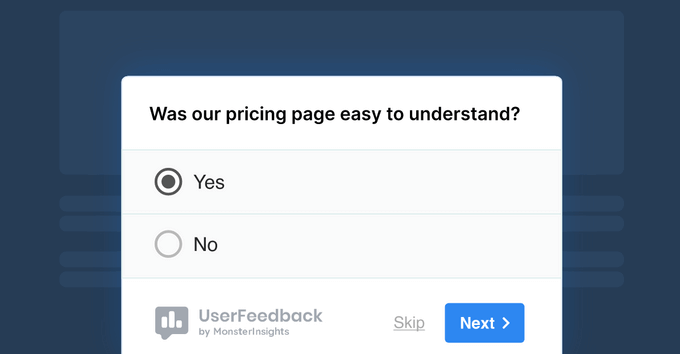
Creating Content for Your Target Audience
Once you have chosen your target audience, the next step is to reach out to them with the right content.
You can now narrow down your list of content ideas to match your target audience’s goals and pain points.
For instance, your audience’s goal could be “losing weight,” and their challenge is that they cannot go to the gym.
This allows you to look for ideas around ‘working out at home’ and ‘exercising without gym equipment.’
To learn more, see our beginner’s guide on how to do keyword research for your WordPress blog.
The following are some essential WordPress tools that you can use to optimize your content for your target audience further.
1. All in One SEO for WordPress
Once you start writing content for your specific audience, you will realize that there is already a lot of similar content out there.
How do you beat them and ensure your customers can find you?
This is where All in One SEO for WordPress comes in. It is the best WordPress SEO plugin on the market and allows you to optimize your content for more visibility on search engines.
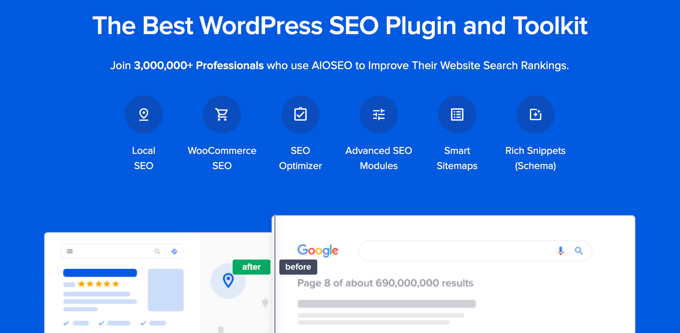
We use it ourselves for everything from meta tag optimization to technical SEO. You can learn more about our experiences with it in our detailed AIOSEO review.
One feature we love is the TruSEO score, which is displayed inside the WordPress editor with practical tips to improve your content.
Plus, it comes with a built-in headline analyzer tool to help you write catchy headlines to improve your organic click-through rate.
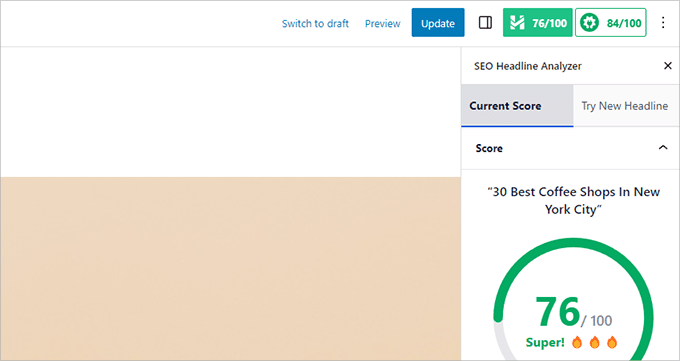
AIOSEO also includes integration with ChatGPT AI to generate your SEO title and meta descriptions.
Other notable features include powerful XML sitemaps, schema markup, focus keyphrases, and free Semrush integration.
To learn more, see our tutorial on how to set up All in One SEO for WordPress.
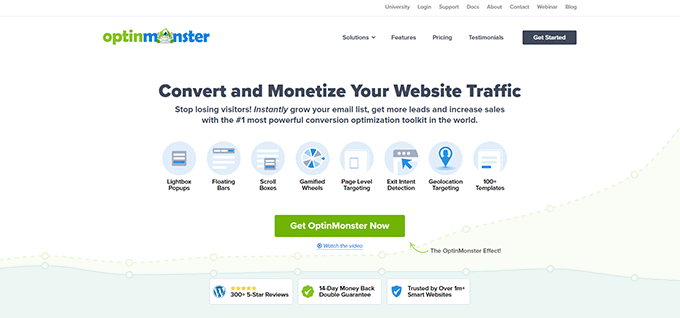
Bringing your target audience to your website is only the first part of the customer journey. Next, you need to convince them to make a purchase or sign up.
Research shows that more than 70% of people visiting your website will leave in merely a few seconds without making a purchase.
Luckily, there are tools like OptinMonster. It is the best conversion optimization software on the market. It allows you to easily convert your target audience into paying customers and subscribers.
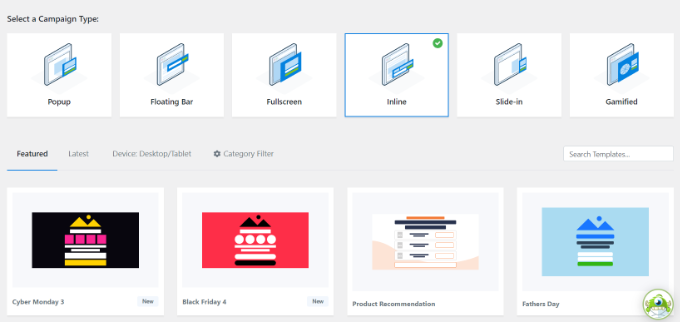
OptinMonster also allows you to use intuitive marketing tools like lightbox popups, countdown timers, header and footer banners, and more to convert users.
With its powerful targeting features, you can show personalized messages to users at a precise time for maximum impact.
We enjoy using OptinMonster here at WPBeginner. We use it to create our popups, slide-ins, and special offer banners to help improve our growth strategy.
Curious about our success with OptinMonster? Check out our full OptinMonster review, or see our proven methods to grow our email list.
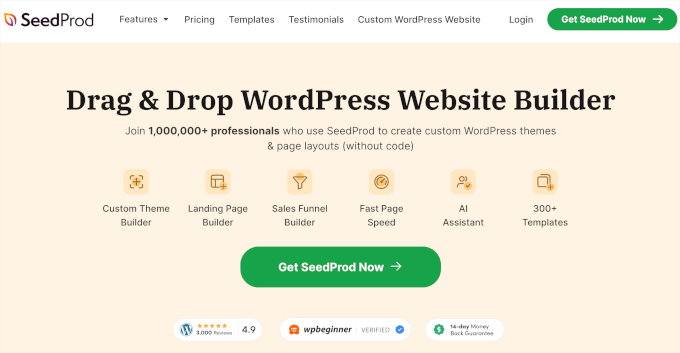
Now, let’s say you want to run an ad campaign for the upcoming holidays. This campaign targets a specific segment of your target audience.
However, sending them directly to your homepage doesn’t provide the most relevant and compelling content.
This is where SeedProd can help. It is the best WordPress page builder plugin on the market and allows you to create beautiful landing pages or custom pages for your website quickly.
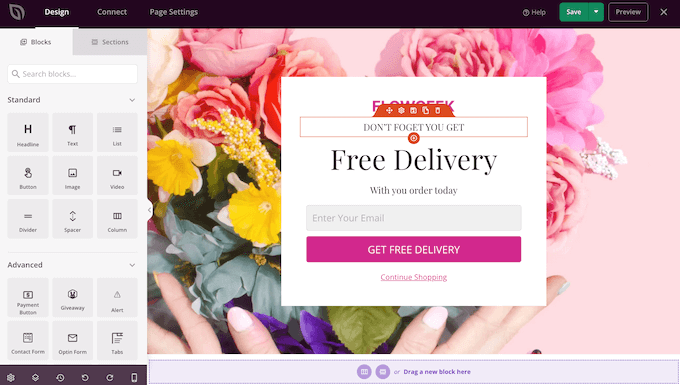
It uses an intuitive drag-and-drop design tool and comes with dozens of templates that are optimized for sales and conversions.
It comes with support for WooCommerce and dozens of ready-made templates to easily create any kind of page you need.
We’ve seen impressive results from our partner brands who have built their entire websites using SeedProd. You can learn more about what this plugin offers in our detailed SeedProd review.
For details on how to create high-converting landing pages, see our guide on creating landing pages in WordPress.
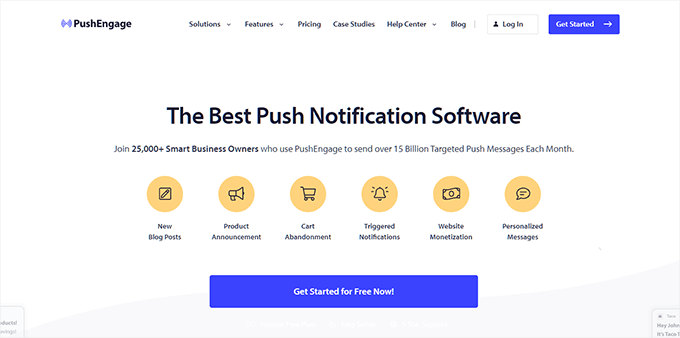
As a marketer, your goal is to open a communication channel with your users before they leave your website.
There are a bunch of tools you can use to achieve this. This includes social media marketing, email marketing, paid search campaigns, or push notifications.
Push notifications are custom messages with links that you can send as notifications to users’ web browsers.
PushEngage is the best push notification software on the market. It enables you to send push notifications to your users regardless of which device they are using (mobile or desktop).
It comes with powerful targeting features that allow you to send personalized messages to your users. Plus, you can automatically segment your target audience for more effective messaging.
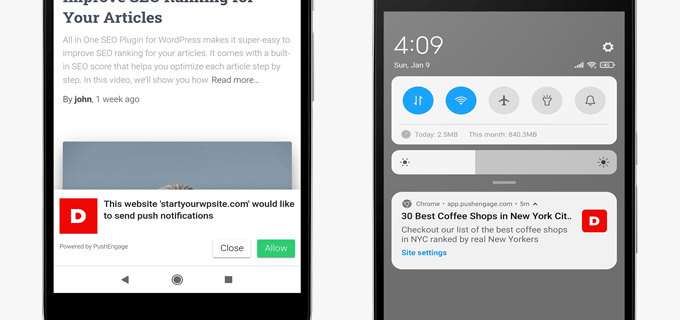
We rely on PushEngage here at WPBeginner to keep our readers informed about new tutorials and WordPress updates through push notifications. For more information about the plugin, read our in-depth PushEngage review.
For step-by-step setup instructions, check out our tutorial on how to add web push notifications to your WordPress site.
We hope this article helped you learn how to choose a target audience for blogs. You may also want to see our complete WordPress SEO guide or take a look at our tutorial on how to get more traffic to your website.
If you liked this article, then please subscribe to our YouTube Channel for WordPress video tutorials. You can also find us on Twitter and Facebook.





Dennis Muthomi
The Google Analytics section is super helpful! I manage a client sites in the lifestyle niche, and the data we get about audiences is incredibly valuable.
Quick tip from my experience: Keep checking and updating those customer personas. I’ve seen firsthand how audience preferences change over time. Keeping profiles fresh has really helped my clients stay connected with their readers.
Jiří Vaněk
I didn’t consider identifying my target audience when I first started the blog, and I didn’t take any steps in that direction. That was a mistake because, as a result, the blog was quite scattered at the beginning. I tried to cover practically the entire spectrum of users but eventually realized that’s not feasible. I only did a thorough research after a year and chose to target an informational audience. It wasn’t until I specifically focused the blog on a certain group of people that I began to see increased traffic. Thanks for more great tips on how to further identify and target the exact users who not only search for the content but may also become part of the community.
David Lim
Nice! I sense some overlap between this article, visitor intent and keyword types by intent for some reason. Analytical tools can help a lot here.
Richard Matt
Interesting content!
WPBeginner Support
Glad you think so
Admin
Oyatogun Oluwaseun Samuel
Great article , thanks for sharing this!
Defining your target audience is the foundation of a successful blog. I’d add that conducting surveys, polls, or social media listening can provide valuable insights into your audience’s preferences and interests.
Also, considering psychographics (values, interests, and lifestyle) alongside demographics can help create content that resonates on a deeper level.
I want to ask, if you have an article on your blog here that details effective ways to segment and refine your target audience as your blog grows?
WPBeginner Support
We do not have a specific article at the moment, that would require testing based on your specific audience so a good starting point would be to ensure you have an analytics tool on your site to help you track what your audience is most interested in.
Admin
Horace E. Scobie
Informative. Sure points to the nitty-gritty that I need to get my site off the ground. Thanks for pointers such as the AISEO plugin that integrates with Semrush.
WPBeginner Support
You’re welcome!
Admin
Peter Iriogbe
This article has given me additional ideas on how to find my target audience. Before, I mostly used Google Analytics to check out my user’s intent and then construct posts that interest them. But now I have learned more ways to find them. Thank you
WPBeginner Support
You’re welcome
Admin
A Owadud Bhuiyan
Thanks for sharing how to choose a target audience.
Have you any articles regarding how to rearrange / arrange your blog page?
WPBeginner Support
We have some articles that are close but we would first recommend checking with your specific theme’s support and they may have a built-in method for customizing your blog page.
Admin
A Owadud Bhuiyan
I have not selected any themes yet. I am just planning.
Have any articles regarding the best themes for blogging?
WPBeginner Support
We have a list of themes to consider that you can take a look at below:
https://www.wpbeginner.com/showcase/best-free-wordpress-blog-themes/